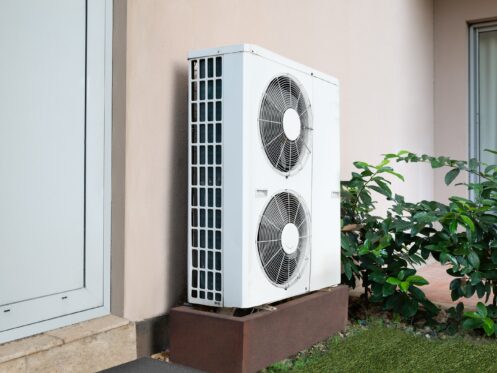When it comes to evaluating heating, ventilation, and air conditioning (HVAC) systems, energy efficiency is the foremost factor to consider. Energy efficiency is the ability to accomplish a particular task and produce results with minimal energy input. It is a principle of maximizing useful work without wasting energy. When it comes to HVAC systems, energy efficiency means using the least amount of energy to control indoor temperatures. Essentially, energy-efficient systems can “do more with less.”
Ductless mini-splits are HVAC systems powered by electricity. They can handle heating and cooling through a heat transfer process that involves refrigerants. When compared to other electricity-powered HVAC systems, mini-splits are more energy-efficient. These systems have been gaining popularity across Oklahoma City in recent years thanks to their optimal energy efficiency. At True Climate Heat + Air, we get questions from many clients who want to know if mini-splits use a lot of electricity. The answer is no. Nevertheless, it is important to understand how these systems promote energy efficiency while delivering comfort.
Understanding Modern Ductless Mini-Split Systems
If you’re new to the world of mini-splits, you need to understand how they differ from traditional HVAC systems. A mini-split HVAC system delivers heating and cooling without relying on ductwork to distribute air and regulate indoor temperatures. These systems feature simple and efficient designs that mainly consist of an outdoor unit connected to various indoor units through conduits.
Essentially, ductless mini-splits streamline the indoor climate control process. If you are familiar with central HVAC systems, you know there’s an outdoor unit that houses the compressor and condenser. Mini-splits also feature outdoor units, although they are considerably smaller and quieter. The outdoor unit handles the refrigerant compression and condensation processes. The refrigerant fluid is pumped through thin copper tubing to the indoor units on walls or ceilings within living spaces.
Each mini-split unit contains a fan and an evaporator coil. These elements enable the circulation of cool or warm air directly into living spaces or zones. Beyond these core components, modern mini-splits offer advanced features to enhance their performance and user experience. Variable-speed compressors, for example, allow mini-split systems to adjust their output. This feature matches the heating or cooling demands with precision instead of turning on and off. When paired with smart thermostats, mini-splits allow even more optimal temperature control.
Ductless Mini-Split Advantages
Flexibility and energy efficiency are the main benefits of mini-split systems. The ductless advantage eliminates the energy losses that central HVAC systems often experience. No ductwork means that you don’t have to worry about significant air leaks or wasted energy.
The ability to control individual indoor units allows for zoned heating and cooling is another major advantage. You can precisely adjust and manage the temperature in all living spaces and zones to specific needs. This eliminates the need to heat or cool unoccupied spaces, thus further enhancing energy savings.
Modern mini-split systems are often installed with smart thermostats. This advantage is crucial to promote HVAC energy efficiency. Smart thermostats use advanced algorithms and connectivity to learn your heating and cooling preferences. These smart home automation features automatically adjust temperatures based on schedules and occupancy patterns. Automated temperature control minimizes energy waste by ensuring that your system only operates when necessary.
Let’s say you have a mini-split system coupled with a smart thermostat and motion detection sensors. This system can detect when you are home to automatically lower the temperature. If the thermostat algorithm has learned your household schedule, it can pre-cool your home in anticipation of your return. These devices also provide detailed energy usage reports, metrics, and analytics, thus allowing you to track electricity use. When smart thermostats connect to WIFI networks, they allow you to monitor and adjust temperatures from anywhere.
Mini-Split Power Consumption
The electrical consumption of mini-split systems varies according to specifications and the load requirements of the living spaces. The specifications refer to size and capacity; the load means how much heating and cooling you need.
Leading manufacturers of mini-split systems indicate that their products use approximately 800 watts on average. A more detailed range would be 600 to 1,000 watts per hour for cooling, and up to 1,500 watts for heating. Exactly how much electricity will vary according to function, external temperature, and the number of living spaces or zones.
To understand how mini-split HVAC systems are easier on your monthly bill, remember that you are charged for kilowatt-hours (kWh). One kWh represents the energy powering a 1,000-watt device for one hour. We can calculate kWh by dividing the mini-split wattage by 1,000. For example, an 800-watt mini-split would be 0.8 kWh per hour. If the system will pump refrigerant at full power all day, 0.8 kWh multiplied by 24 hours is 19.2 kWh per day.
It is crucial to understand that mini-splits don’t operate at full power constantly. As mentioned before, variable-speed compressors adjust their output with precision instead of cycling on and off. This means that the 19.2 kWH estimate above would be significantly lower, particularly with a smart thermostat. Modern mini-split systems automatically adjust their power usage, so they rarely run at full capacity for 24 hours.
To ensure optimal energy use and minimize electricity consumption, the size of a mini-split must match living spaces. This is when load calculations consider the square footage, number of occupants, and insulation. Our technicians make these calculations before installing mini-split systems. A unit that is too small would work harder, thus consuming more electricity. An oversized unit would waste more energy unless it features a variable-speed compressor.
The mini-split capacity determines the amount of heat transferred in and out of your home or business. This is directly tied to the load calculations and system functionality. Mini-split HVAC systems come in two main configurations: single-zone and multi-zone. The former is ideal for individual spaces or open floor plans with one indoor and one outdoor unit. Multi-zone systems are for multiple rooms using a single outdoor unit and several indoor units. Each indoor unit in a multi-zone system offers independent temperature control, thus allowing for personalized comfort in each space.
Other factors can also influence mini-split energy efficiency. Higher ceilings, for example, increase the volume of air to condition, thus demanding more energy. Extreme temperatures will invariably place higher demands on HVAC systems, thus requiring higher efficiency ratings. Then you have windows, which can restrict the heat transfer process and lower efficiency. Indoor airflow restrictions such as obstacles would also reduce efficiency and raise your monthly bills.
At True Climate Heat + Air, your comfort and energy efficiency always come first. Since 2005, we have been providing quality commercial HVAC and residential heating and cooling services across Oklahoma City. We offer mini-splits installation, repair, and maintenance services. Our HVAC technicians can also install and service other systems, including heat pumps and furnaces. We also offer financing on approved credit through our partnership with GreenSky.
To get more information about energy-efficient solutions for your home or business, contact True Climate Heat + Air in Oklahoma City Today.


